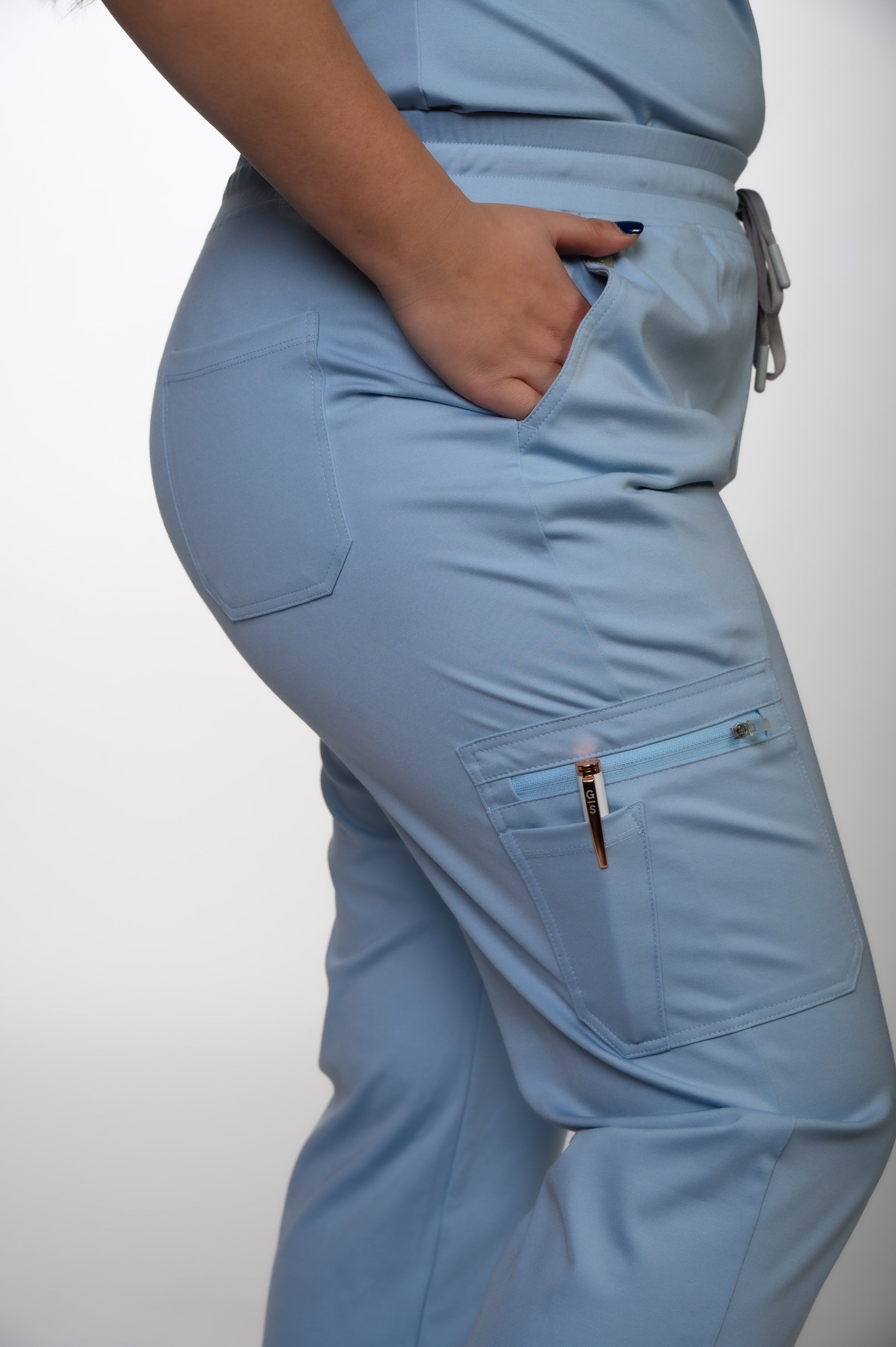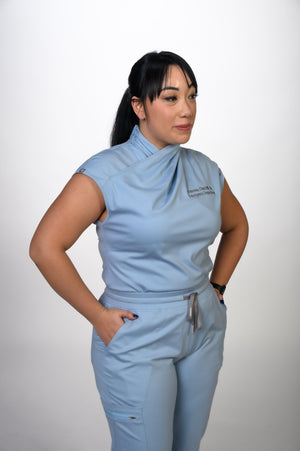Should your scrubs have more pockets?
“I feel like all three of my pockets are an endless abyss where I dig my hand and struggle to find certain things. I'm about to start clinicals (first time, yay!) So I don't want to keep that habit of rummaging”
Source: Student Nurse on Reddit
If this sentiment resonates with you, you're not alone. Many healthcare professionals, from newbies to veterans, face the daily challenge of disorganized scrub pockets. But it doesn’t have to be this way.
Imagine effortlessly finding exactly what you need without the frantic search. Better put — imagine not having more pockets but maximizing the functionality of the pockets you already have.
In this blog post, we'll explore three compelling reasons why your scrubs shouldn’t have more pockets and how you can make the most of the pockets you already have.
Should Your Scrubs Have More Pockets?
Do you mean more than what you already have? Then, no!
Look! Asking if your scrubs should have more pockets is a valid question.
Many healthcare professionals think that more pockets might solve their organizational woes. However, the reality is that adding more pockets can actually create more problems than it solves.
Picture this: you’re in the middle of a busy shift, and you have to sift through multiple pockets to find a single item. This can be both time-consuming and frustrating.
Instead of focusing on the quantity of pockets, prioritize the quality and organization of the pockets you already have.
How Many Pockets Should Your Scrub Have?
Ideally, your scrubs should have enough pockets to carry your essential items comfortably.
But how many pockets is enough? This depends on your specific needs and job requirements.
Generally, having between three to six visible pockets is sufficient for most healthcare professionals. This allows you to carry the essentials without becoming overwhelmed or disorganized.
What Should You Keep in Your Scrub Pockets?

Knowing what to keep in your scrub pockets can greatly enhance your efficiency and comfort throughout your shift.
So, what should actually go in your scrub pockets? Here are some essential items that most healthcare professionals find useful:
- Pen: A reliable pen is indispensable for jotting down notes, updating charts, or signing documents. Consider carrying a backup pen just in case.
- Small Notepad: Handy for writing quick notes, patient details, or reminders. A compact notepad can easily fit into your pocket without taking up too much space.
- ID Badge: Keeping your ID badge in a readily accessible pocket ensures you can quickly display it when needed, whether you're entering secure areas or identifying yourself to patients.
- Alcohol Swabs: These are crucial for maintaining hygiene and cleaning surfaces or skin before injections. They’re small and easy to carry, making them perfect for a pocket.
- Pair of Scissors: Medical scissors are essential for cutting bandages, tape, or clothing in emergencies. Having them in an easily reachable pocket can save valuable time.
- Phone: While it’s important to minimize distractions, having your phone handy for communication or accessing medical apps can be very useful.
- Hand Sanitizer: A small, portable bottle of hand sanitizer can help you maintain hand hygiene between patient interactions, especially when soap and water aren't readily available.
- Penlight: Useful for checking pupils or illuminating hard-to-see areas. A penlight is a compact tool that fits easily into a pocket.
-
By carrying only the most frequently used and essential items, you can keep your scrub pockets organized and efficient. Overloading your pockets can lead to bulkiness and difficulty finding what you need quickly. Aim for a streamlined approach, ensuring that each item has a designated place and purpose.
This method not only enhances your efficiency but also helps in maintaining a professional appearance. Well-organized pockets mean less rummaging and more time focusing on patient care.
How to Organize Your Scrub Pockets?
Organizing your scrub pockets can significantly improve your efficiency and reduce the stress of finding necessary tools during your shift.
Here are some practical tips on how to keep your scrub pockets well-organized:
#1 Prioritize Based on Usage
Identify which items you use most frequently and ensure they are in the most accessible pockets.
- High-Frequency Items: Items like pens, a notepad, and a penlight should be kept in your chest pocket or another easily reachable pocket.
- Medium-Frequency Items: Tools such as scissors, hemostats, and hand sanitizer can be placed in side pockets for quick access.
- Low-Frequency Items: Items that you don’t use as often, like extra gloves or a spare face mask, can be stored in less accessible pockets.
#2 Designate Specific Pockets for Specific Items
Assign each item to a specific pocket to avoid confusion and ensure you always know where to find what you need.
- Left Side Pocket: Keep your penlight, scissors, and hemostats here.
- Right Side Pocket: Store your notepad and pens for easy access.
- Chest Pocket: This is a great spot for your phone, pager, or ID badge.
#3 Use Pocket Organizers
Consider using pocket organizers or clip-on pouches. These can help keep smaller items from getting lost in the depths of your pockets and make it easier to grab what you need quickly.
- Pocket Inserts: These can provide multiple compartments within one pocket, making it easier to organize and access your tools.
- Clip-On Pouches: These can be attached to your scrub pants or waistband for additional storage and organization.
#4 Maintain Cleanliness and Hygiene
Hygiene is crucial in a healthcare setting. Organize your pockets to minimize the risk of contamination.
- Separate Clean and Dirty Items: Designate specific pockets for clean items and others for potentially contaminated items.
- Use Ziplock Bags: Small ziplock bags can keep items like bandages or alcohol swabs clean and organized.
#5 Regularly Declutter and Reorganize
At the end of each shift, take a moment to declutter your pockets. Remove any items you don’t need for the next shift and ensure everything is in its designated place.
- Daily Decluttering: Empty your pockets completely, clean them out, and reorganize before your next shift.
- Weekly Deep Clean: Once a week, give your scrubs a thorough inspection and clean to ensure no debris or germs are lingering.
#6 Label Your Pockets
If you have multiple pockets, consider labeling them or using color-coded tags to remind you where each item belongs. This can be especially helpful during hectic shifts.
#7 Keep Essential Items Visible
For items you need to access immediately, like your ID badge or penlight, ensure they are always visible and within reach.
By noting these things when organizing your scrubs, you can transform your scrub pockets from a cluttered mess into a well-organized toolkit.
This not only improves your efficiency but also enhances your overall performance and reduces stress during your shifts.
Pockets In Scrubs: What to Consider When Choosing
When selecting the perfect scrubs, pockets play a crucial role in functionality and convenience.
Here are important factors to consider:
#1 The Type of Scrub Pockets You Want
Different scrubs come with various types of pockets, each serving unique purposes. It's essential to choose scrubs that offer the right type and number of pockets to suit your specific needs.
- Chest Pockets: Ideal for items you need to access quickly, like pens, notepads, or ID badges. These are usually placed high on the scrub top, making them easy to reach.
- Pant Pockets: These include side pockets or cargo pockets on scrub pants, perfect for larger items like gloves, stethoscopes, or a small notebook.
- Hidden Pockets: Discreet pockets that offer additional security for personal items such as your phone, wallet, or keys. These are great for keeping valuable items safe and out of sight.
#2 How Functional Your Scrub Pockets Are
Ensuring that the pockets are functional and easy to access is key to maximizing their utility. Here’s what to look for:
- Secure Closures: Pockets with secure closures like zippers, Velcro, or buttons can help keep your items safe and prevent them from falling out. This is especially important for items like scissors or hemostats.
- Easy Access: Pockets should be easily accessible without requiring you to twist or turn awkwardly. Consider scrubs with pockets strategically placed where you can reach them comfortably.
- Reinforced Stitching: Pockets that are reinforced with double stitching can handle more weight and are less likely to tear, making them more durable for carrying essential tools.
#3 What You Want To Keep in Them
Thinking about the items you need quick access to can help you decide how to organize your pockets effectively.
Think about the items you need quick access to, such as a penlight, stethoscope, or hand sanitizer. Keep these items in the most accessible pockets.
"You Don’t Need More Pockets, You Just Need More Organization"

As a healthcare professional, you know how important it is to have functional and comfortable scrubs.
One common question that often arises is, "How many pockets should my scrub have?"
While it might seem like more pockets are always better, there are several reasons why this might not be the case.
3 Reasons Why Your Scrubs Shouldn’t Have More Pockets
#1 Excessive Weight and Discomfort
Adding more pockets to your scrubs may seem like a solution to carry more items, but it can lead to unnecessary weight and discomfort. Each additional pocket filled with tools, pens, or personal items adds to the overall weight of your scrubs. This can result in:
- Strain on Your Body: Carrying excess weight can strain your back, shoulders, and neck, leading to discomfort or even injury.
- Restricted Movement: Bulky pockets can restrict your movement, making it harder to bend, stretch, and perform your duties effectively.
- Unprofessional Appearance: Overstuffed pockets can give off a messy and unprofessional appearance, which is not ideal in a healthcare setting.
#2 Hygiene Concerns
More pockets mean more areas for germs and bacteria to accumulate. This can pose hygiene concerns, especially in a healthcare environment where cleanliness is paramount. Here's why:
- Increased Risk of Cross-Contamination: Pockets can harbor bacteria and pathogens, especially if not cleaned regularly. This can increase the risk of cross-contamination between patients.
- Difficult to Clean: With more pockets, it becomes more challenging to ensure thorough cleaning and disinfection. This can leave behind hidden germs and contaminants.
#3 Organization and Efficiency
Having more pockets doesn’t necessarily equate to better organization. In fact, it can lead to the opposite – a disorganized mess. Here's how:
- Difficulty Finding Items: With multiple pockets, finding specific items can become a scavenger hunt, leading to wasted time and frustration.
- Overcrowded Pockets: Overloading pockets with too many items can make it difficult to access what you need quickly and efficiently.
- Loss of Focus: Constantly searching through pockets can distract you from your primary task and patient care.
While the temptation to add more pockets to your scrubs may be strong, it's essential to consider the potential drawbacks.
Instead of succumbing to pocket overload, focus on maximizing the functionality of the existing pockets on your scrubs to enhance comfort, hygiene, and efficiency in your daily practice.








